Order Perciformes Species P. hepatus Higher classification Paracanthurus Conservation status Least Concern | Phylum Chordata Scientific name Paracanthurus hepatus Mass 600 g (Adult) Length 25 – 31 cm (Adult) | |
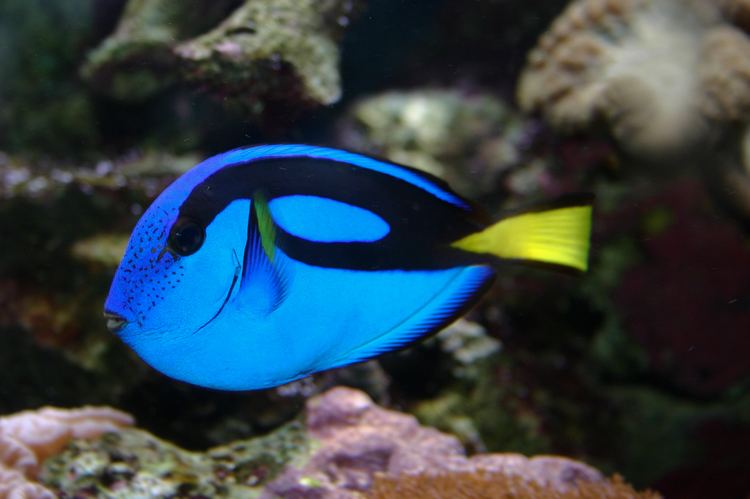 | ||
Genus ParacanthurusBleeker, 1863 Lifespan 8 – 20 years (In captivity) Similar Acanthuridae, Yellow tang, Clownfish, Acanthurus leucosternon, Ocellaris clownfish | ||
Blue tang paracanthurus hepatus mp4
Paracanthurus hepatus is a species of Indo-Pacific surgeonfish. A popular fish in marine aquaria, it is the only member of the genus Paracanthurus. A number of common names are attributed to the species, including regal tang, palette surgeonfish, blue tang (leading to confusion with the Atlantic species Acanthurus coeruleus), royal blue tang, hippo tang, flagtail surgeonfish, Pacific regal blue tang, and blue surgeonfish.
Contents
- Blue tang paracanthurus hepatus mp4
- Description
- Ecology
- Diet
- Life cycle
- Importance to humans
- Aquarium life
- In popular culture
- References
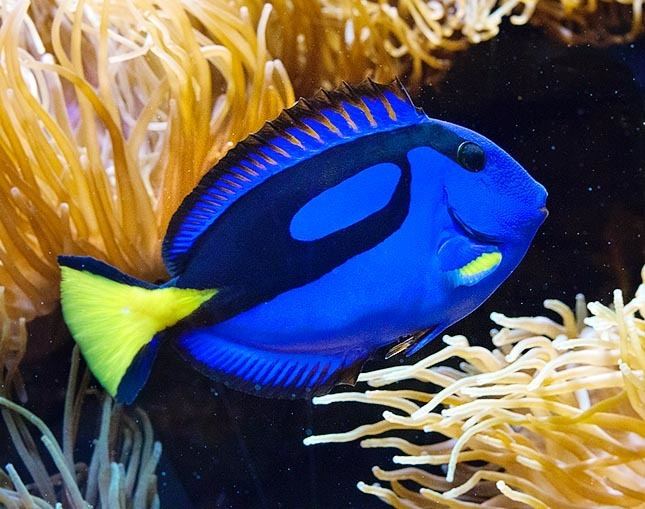
Description
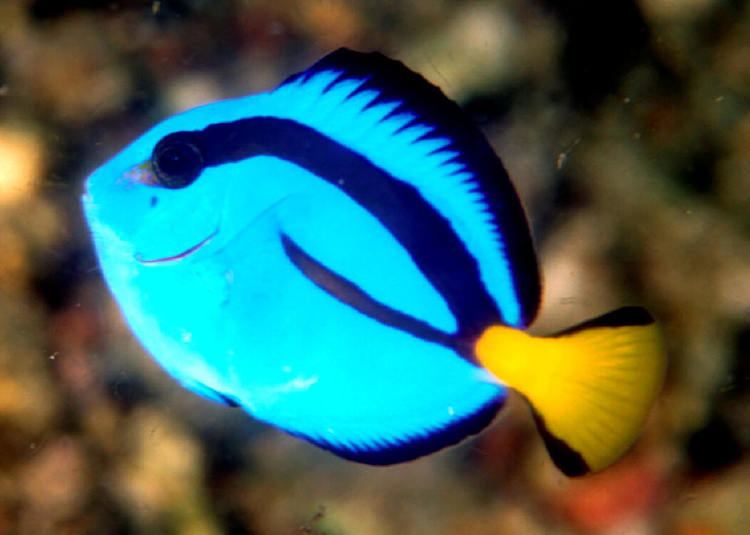
Paracanthurus hepatus has a royal blue body, yellow tail, and black "palette" design. The lower body is yellow in the west-central Indian Ocean. It grows to 30 cm (12 in.). This fish is rather flat, like a pancake, with a circular body shape, a pointed snout-like nose, and small scales. The blue tang has nine dorsal spines, 26–28 dorsal soft rays, three anal spines, and 24–26 anal soft rays.
Ecology
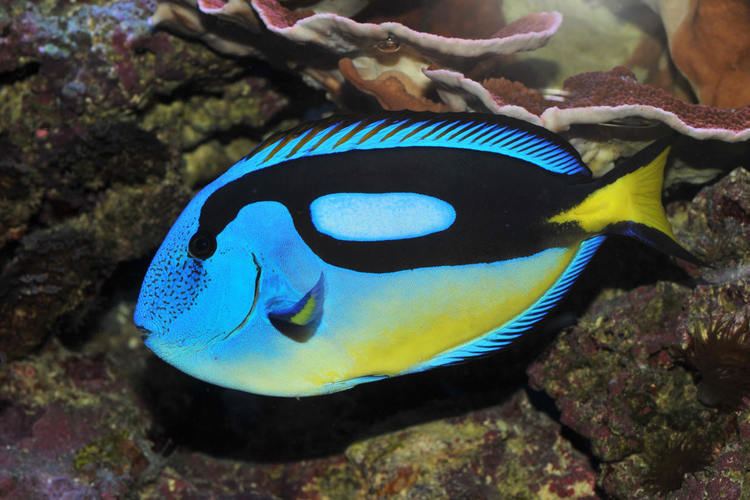
The species' range is broad, but it is common nowhere. It can be found throughout the Indo-Pacific. It is seen in the reefs of the Philippines, Indonesia, Japan, the Great Barrier Reef of Australia, New Caledonia, Samoa, East Africa, and Sri Lanka. The regal blue tang is one of the most common and most popular marine aquarium fish all over the world. They live in pairs, or in small groups of 8 to 14 individuals.
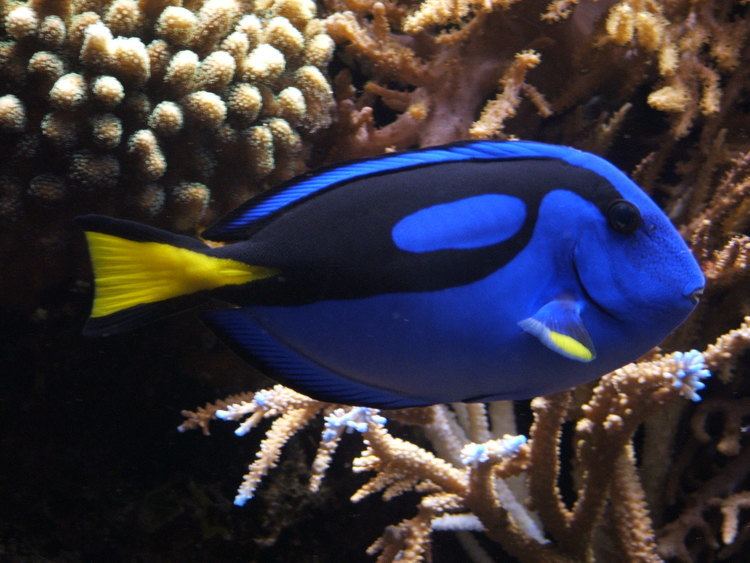
The regal blue tang is ranked LC (least concern) by the World Conservation Union (IUCN), but is of low vulnerability.
Diet

As a juvenile, its diet consists primarily of plankton. Adults are omnivorous and feed on plankton, but will also graze on algae. Spawning occurs during late afternoon and evening hours. This event is indicated by a change in color from a uniform dark blue to a pale blue. The fish is important for coral health as it eats algae that may otherwise choke it by overgrowth.
Life cycle
Males aggressively court female members of the school, leading to a quick upward spawning rush toward the surface of the water during which eggs and sperm are released. The eggs are small, approximately 0.8 mm in diameter. The eggs are pelagic, each containing a single droplet of oil for flotation. The fertilized eggs hatch in twenty-four hours, revealing small, translucent larvae with silvery abdomens and rudimentary caudal spines. Regal blue tangs can also, when faced with danger or dark spaces, make themselves semi-transparent, in order to help with evasion and light passivity, respectively. These fish reach sexual maturity at 9–12 months of age.
Importance to humans
The regal blue tang is of minor commercial fisheries importance, however, it is a bait fish. The flesh has a strong odor and is not highly prized. This fish may cause ciguatera poisoning if consumed by humans. However, regal blue tangs are collected commercially for the aquarium trade. Handling the tang risks the chances of being badly cut by the caudal spine. These spines, on both sides of the caudal peduncle, are extended from the body when the fish becomes excited. The quick, thrashing sideways motion of the tail can produce deep wounds that result in swelling and discoloration, posing a risk of infection. It is believed that some species of Acanthurus have venom glands while others do not. The spines are used only as a method of protection against aggressors. Two sharp spines stick out at the caudal peduncle—the area where the tail joins the rest of the body.
Aquarium life
The regal tang is commonly found in the aquarium trade, despite being one of the more fragile popular fish. In particular, it needs a source of spirulina to regularly graze from, and achieves a respectable size of 30 cm (12 inches). In addition, it is prone to parasitic infections and lateral line disease.
In popular culture
In the 2003 Disney/Pixar film, Finding Nemo, and its 2016 sequel, Finding Dory, the main character Dory (voiced by Ellen DeGeneres) is a regal blue tang, as well as her parents, Jenny and Charlie, who appear in the 2016 sequel, Finding Dory.
